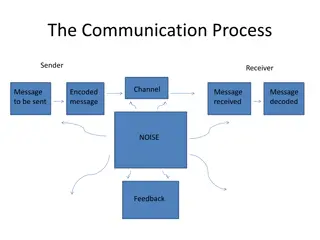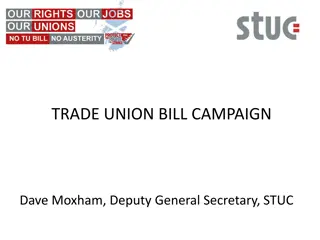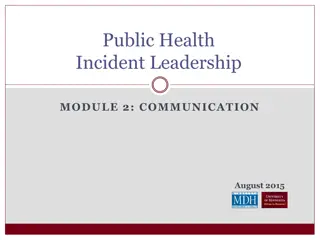Exploring Effective Communication in Union Environments
In this session, we delve into effective communication within union settings, identifying and removing barriers to successful communication. We discuss the importance of non-verbal cues, explore common understanding, and examine communication models like Shannon & Weaver. Key skills such as active listening, clear writing, and appropriate language usage are highlighted to enhance communication effectiveness.
Download Presentation

Please find below an Image/Link to download the presentation.
The content on the website is provided AS IS for your information and personal use only. It may not be sold, licensed, or shared on other websites without obtaining consent from the author. Download presentation by click this link. If you encounter any issues during the download, it is possible that the publisher has removed the file from their server.
E N D
Presentation Transcript
Session Aim: To explore effective communication, within the Union environment. Also, to identify and eliminate barriers to effective communication. C:/Users\Ian\Desktop\All Reps Induction Resources\Day Four
Session Objectives: To describe what is effective communication. To discuss how we communicate using non- verbal/body language. To discuss barriers to effective communication. To take part in a communication skills task to illustrate the value of active listening in communication. C:\Users\Ian\Desktop\All Reps Induction Resources\Day Four
What Is Communication? The word Communication is derived from the Latin word Communis , Meaning to make common . http://en.wiktionary.org/wiki/communis C:/Users\Ian\Desktop\All Reps Induction Resources\Day Four
What Is Communication? Communication Is The Achievement Of A Communication Is The Achievement Of A Common Understanding Between Two Or More Common Understanding Between Two Or More People People i.e. Where Both Attribute the Same i.e. Where Both Attribute the Same Meaning To The Information That Is Exchanged. Meaning To The Information That Is Exchanged. Encarta Dictionary English(UK) Encarta Dictionary English(UK) C:/Users\Ian\Desktop\All Reps Induction Resources\Day Four
Shannon & Weavers Academic Communication Model Based on Shannon & Weaver s Model. C:\Users\Ian\Desktop\All Reps Induction Resources\Day Four
Something Missing? Based on Shannon & Weavers Model. C:/Users\Ian\Desktop\All Reps Induction Resources\Day Four
Same Model But? Feedback/Response C:/Users\Ian\Desktop\All Reps Induction Resources\Day Four
Effective Communication Skills Listening : Speaker & listeners. Asking the right questions. Using the proper body language. Relating someone else s information accurately. Writing Clearly. Speaking in language appropriate to listeners. C:/Users\Ian\Desktop\All Reps Induction Resources\Day Four
Communication Methods Verbal Non Verbal Letters. E mails. Reports. Handouts. Body Language. Visual Images. Other Social Media. Telephone. Face to Face Conversation. Video Conferencing. Skype/Facetime Internet social-networks & chat rooms/Blogs Speeches. Lectures. C:/Users\Ian\Desktop\All Reps Induction Resources\Day Four
Communication Methods Verbal Non Verbal Strengths Strengths Written material is proof of communication? Written material perceived as authoritative & tangible. The role of body language. Can convey feelings. Voice inflections emphasise. Weaknesses Weaknesses Does not convey feelings, thoughts, emphasis or expression/inflection. Cannot give long list of memorable details. C:/Users\Ian\Desktop\All Reps Induction Resources\Day Four
Barriers To Communication Verbal Non Verbal Rolling eyes. Interrogating. Quick/Slow movements. Criticizing. Blaming. Arms crossed. Shaming. Legs crossed. Moralizing. Slouching. Preaching. Doodling.(fiddling with Name-calling. Mobile phones) Avoiding eye contact. C:/Users\Ian\Desktop\All Reps Induction Resources\Day Four
Other Barriers Layout of room, position of table and chairs. Visual aids must be visible to listeners if used. Teaching at the incorrect level. Using Jargonese and acronyms. Experiential filters? Noise/Distractions. Ergonomics/Comfort, Hunger & Thirst. (Maslow) Medium used to convey message. C:/Users\Ian\Desktop\All Reps Induction Resources\Day Four
Task What do you think I mean if I say the word: Speed ? C:/Users\Ian\Desktop\All Reps Induction Resources\Day Four
Task Task What do you think I mean if I say the word: Speed ? Velocity, Distance over Time; rate of progress. Going Fast. Exceeding The Speed Limit. Drugs A Film with Keanu Reeves & Sandra Bullock The Footballer Who Played For Everton, Newcastle and managed Wales National Football Team before his untimely Death. C:/Users\Ian\Desktop\All Reps Induction Resources\Day Four
English Is A Complex Language So any message is distorted by: The Experiences of both speaker and Listener. The Medium Used to communicate. C:/Users\Ian\Desktop\All Reps Induction Resources\Day Four
Filters as Barriers Filters as Barriers There are Two sets of Filters to consider! There are Two sets of Filters to consider! 1) 1) The Sender s filters influence the expression of The Sender s filters influence the expression of the message with the chosen words, gestures the message with the chosen words, gestures and voice tones/inflections used. and voice tones/inflections used. 2) 2) The Receiver's filters define how the message is The Receiver's filters define how the message is received & understood. received & understood. SO . SO . C:/Users\Ian\Desktop\All Reps Induction Resources\Day Four
Filters as Barriers Filters as Barriers If you are not interested in football, or have never seen Everton, Newcastle or Wales Play, then you may never have heard of Gary Speed the footballer. Therefore your experience, or lack of it, excludes the footballer as a possible response. If you are someone who deals everyday with drugs and drug addicts, (social worker) the first thing you may think of is drugs. Alternatively, if you are a scientist planning to send a rocket into space, the first thing you may think of is distance over time . Our individual experiences changes the meaning of the words Our individual experiences changes the meaning of the words we hear. That experience acts like a filter, removing some we hear. That experience acts like a filter, removing some meanings and accentuating others. meanings and accentuating others. C:/Users\Ian\Desktop\All Reps Induction Resources\Day Four
Media As Barriers If I write the word speed I have two common alternatives: speed or Speed . The latter version has a capital letter at the start which, when not at the start of a sentence, strongly implies it is a proper name. However, when I say the word, the listener is unable to discern whether I have used a capital letter or not. That is, The medium used (written or spoken word) also That is, The medium used (written or spoken word) also acts as a filter on the information communicated and can acts as a filter on the information communicated and can distort it s meaning. distort it s meaning. C:/Users\Ian\Desktop\All Reps Induction Resources\Day Four
Dont Assume. A common mistake made in informing is that the person informing thinks the recipient of the information will attribute the same meaning to it. This is very often not the case! And what s worse when people miscommunicate, they do not even realise that they have misunderstood each other! The informer has assumed the listener has understood. NAFOF ( Never Assume Find Out First) C:/Users\Ian\Desktop\All Reps Induction Resources\Day Four
Feedback The way around this problem is to get feedback from those with whom you have informed on what they have understood by your information. If the feedback agrees, then you have likely communicated (there remains potential for misunderstanding, but is greatly reduced). C:/Users\Ian\Desktop\All Reps Induction Resources\Day Four
Feedback Effective communication therefore involves the following process: Inform. Get Feedback. Check feedback vs. your intended meaning If they agree, then you have communicated and the process ends. If they contradict (or if the potential for misunderstanding remains) re-inform, using different words. Go back to step2 1. 2. 3. 4. 5. 6. C:/Users\Ian\Desktop\All Reps Induction Resources\Day Four
Process WHEN Communicate WHAT WHO TO HOW C:/Users\Ian\Desktop\All Reps Induction Resources\Day Four























